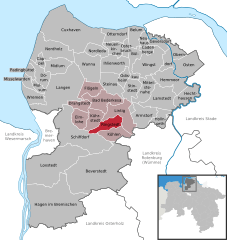Ringstedt
From Wikipedia, the free encyclopedia
| Ringstedt | ||
|---|---|---|
 | ||
| ||
 Ringstedt | ||
Location of Ringstedt within Cuxhaven district 
 | ||
| Coordinates: 53°34′00″N 08°51′00″E / 53.56667°N 8.85000°ECoordinates: 53°34′00″N 08°51′00″E / 53.56667°N 8.85000°E | ||
| Country | Germany | |
| State | Lower Saxony | |
| District | Cuxhaven | |
| Municipal assoc. | Bederkesa | |
| Government | ||
| • Mayor | Erich Glandorf (CDU) | |
| Area | ||
| • Total | 26.26 km2 (10.14 sq mi) | |
| Elevation | 7 m (23 ft) | |
| Population (2012-12-31)[1] | ||
| • Total | 837 | |
| • Density | 32/km2 (83/sq mi) | |
| Time zone | CET/CEST (UTC+1/+2) | |
| Postal codes | 27624 | |
| Dialling codes | 04708 | |
| Vehicle registration | CUX | |
| Website | www.ringstedt.de | |
Ringstedt (in High German, in Low Saxon Ringst, literally in Ring Stead) is a municipality in the district of Cuxhaven, in Lower Saxony, Germany.
History
Ringstedt belonged to the Prince-Archbishopric of Bremen, established in 1180. In 1648 the Prince-Archbishopric was transformed into the Duchy of Bremen, which was first ruled in personal union by the Swedish Crown – interrupted by a Danish occupation (1712–1715) – and from 1715 on by the Hanoverian Crown.
In 1807 the ephemeric Kingdom of Westphalia annexed the duchy, before France annexed it in 1810. In 1813 the duchy was restored to the Electorate of Hanover, which – after its upgrade to the Kingdom of Hanover in 1814 – incorporated the duchy in a real union and the ducal territory, including Ringstedt, became part of the new Stade Region, established in 1823.
Ringstedt is twinned with the Kentish village of West Farleigh in England. This relationship was built on many years of friendship developed through both communities and their sports clubs.
Sights
St. Fabian Church (est. 13th century), a simultaneum of Reformed and Lutheran congregants.
References
This article is issued from Wikipedia. The text is available under the Creative Commons Attribution/Share Alike; additional terms may apply for the media files.

